A Refined Supervision Model of Rice Supply Chain Based on Multi-Blockchain
Abstract
:1. Introduction
- For a sustainable rice supply chain, existing studies have been unsuccessful in their attempts to efficiently and securely supervise the complex links, data types, participants, and huge real-time data of the rice supply chain in a refined manner.
- The data suitability of the whole flow cycle of the rice supply chain is poor, and regulators are unable to accurately regulate different types of rice data in the rice supply chain by category. It is challenging to cover all types of data given the huge real-time data of the rice supply chain, and the granularity of the regulation of rice supply chain flow data is insufficient.
- The storage performance of blockchain is poor, and it is easy to cause data redundancy. In turn, this will lead to high latency and high concurrency problems, and the throughput of existing research cannot meet the frequent and complex data request requirements of the rice supply chain.
- The security and flexible application compatibility of rice supply chain data transmission based on blockchain is insufficient, and there are challenges in the secure classification, transmission, and application of basic rice data and private data. In addition, the demand for secure multi-party computing of various types of data between enterprises in all aspects of the rice supply chain has increased, and existing research cannot guarantee the safe use of private data for the relevant participating enterprises.
2. Literature Review
- MBRRSM is built based on the main sub-chain architecture in the multi-layer blockchain to serve the refined supervision of the rice supply chain. Improvement in the auditability of rice supply chain data. Promotion of the precise control process of the rice industry. Sustainable development realization of the rice supply chain.
- The rice supply chain flow information is deconstructed and the key information is classified. The data transmission, usage, and storage mechanisms applicable to the rice supply chain are designed to improve the security of cross-chain data transmission and the granularity of regulation, satisfying the need for secure rice data computing and reducing data redundancy in the rice supply chain.
- The SPOP consensus mechanism is designed for MBRRSM based on the POP (Proof of Peers) consensus mechanism, which alleviates the frequent and complex data request consensus of each node in MBRRSM. It reduces the latency and concurrency of MBRRSM.
3. Model
3.1. Analysis of Rice Supply Chain
3.2. Framework
3.3. Data Transmission Mechanism
3.4. Data Usage Mechanism
3.5. Data Storage Mechanism
3.6. SPOP Consensus Mechanism
- (1)
- Each node collects requests: for the supervisor node and the consumer node, the nodes on the main chain: propose their requests to the request pool. For each sub-chain internal node: each node submits its request to the request set, and the service node proposes the sub-chain request set to the request pool.
- (2)
- According to different node data permissions, each supervisor node, consumer node, and service node continuously extracts requests from the request pool. Each supervisory node, consumer node, and service node looks at the request pool header information, determines which requests are not available in the request set within its authority, and extracts the requests that are not available.
- (3)
- Each service node broadcasts requests to the corresponding sub-chain network. Each enterprise node looks at the request set header information, determines the requests that are not in its own request set, and extracts the requests that are absent.
- (4)
- Each enterprise node votes on the request and broadcasts its vote
- (5)
- Each node collects votes from other nodes and when it exceeds 51%, each node reaches consensus and the request is executed.
- (6)
- Each node generates blocks based on the request pool and broadcasts the new blocks
4. Results
4.1. Model Analysis
4.1.1. Security Analysis
4.1.2. Analysis of Model Runs
4.1.3. Information Consensus Analysis
4.1.4. Refined Supervision Analysis
4.2. Prototype System Design and Verification
4.2.1. Prototype System Construction
4.2.2. Business Scenario Application Analysis
4.3. Discussion
5. Conclusions and Future Work
- MBRRSM can guarantee the security of the data automatically collected by the rice supply chain before storing it on the blockchain. However, for some manually entered information, maintaining the security before storing in the blockchain can only be achieved by standardizing the data and training employees within the company. In the future, achieving credible storage of data on top of the blockchain will be a direction of research.
- MBRRSM is a unique supply chain architecture for the complexities of the rice supply chain, the many people involved, and the many types of data. Some modifications to MBRRSM are needed when extending it to other food crops as well as to agricultural and food supply chain regulations.
- MBRRSM supports consumer on-chain and can provide commodity traceability services for consumers, etc. However, multi-layer blockchain is an innovative application of new-generation information technology in the field of agricultural products and food. Ways to improve consumer trust of this new technology remains an important future consideration.
Author Contributions
Funding
Institutional Review Board Statement
Informed Consent Statement
Data Availability Statement
Conflicts of Interest
Appendix A
Appendix A.1. Algorithm A1
| Algorithm A1 Secure Multiparty Computation Contract-A |
| 1: Data Reconfiguration If receive (Mz) //Accept data per data owner S = M1 + M2 + M3 + ……//Build multi-party computing data S Return “Successful data construction” Else “Data build failure” 2: Generate a new S-slice t = 1/2z//MBRRSM multi-party fault tolerance is set to 51%, which means that at least 1/2 of the nodes of the data owner are required. F(x) = S + a1*x1 + a2*x2 + …. + a(t−1)*x(t−1)mod(u)//Constructing polynomials F(x) If Take z unequal x’s and bring them into F (x) Return z (xi, yi) If Send (xi, yi) ->Pz//Assigned to the data owner P Public u Return Destruction of F(x) 3: Data Sharing If x = 0 Return S If receive (xi, yi) (xi, yi) >=t Return send (xi, yi) ->F(x)//Restore shared non-common data S Return S |
Appendix A.2. Algorithm A2
| Algorithm A2 Secure Multiparty Computing Contract-B |
|
1: if Data usage request received Query the number of members the secret has z For (i = 0, i < =z, i++) { i = 0; Send(request)R0->Pz; i++; }//Send request messages to each data owner node Return “Sending successfully” Else “Sending failure” 2: if Receive (Sig (Request) Rz) //Feedback from Data Owners If Sig (Request) Rz = z Return “Allow requests” Else “Request failed” Else “No feedback” |
References
- Pirsaheb, M.; Hadei, M.; Sharafi, K. Human health risk assessment by Monte Carlo simulation method for heavy metals of commonly consumed cereals in Iran-Uncertainty and sensitivity analysis. J. Food Compos. Anal. 2021, 96, 103697. [Google Scholar] [CrossRef]
- Hardin, T.; Kotz, D. Amanuensis: Information provenance for health-data systems. Inf. Process. Manag. 2021, 58, 102460. [Google Scholar] [CrossRef]
- Yu, H.; Li, H.; Mao, D.; Cai, Q. A relationship extraction method for domain knowledge graph construction. World Wide Web—Internet Web Inf. Syst. 2020, 23, 735–753. [Google Scholar] [CrossRef]
- Zhu, Z.; Xu, Z.; Peng, J.; Fei, J.; Yu, P.; Wang, M.; Tan, Y.; Huang, Y.; Zhran, M.; Fahmy, A. The contribution of atmospheric deposition of cadmium and lead to their accumulation in rice grains. Plant Soil 2022, 1–15. [Google Scholar] [CrossRef]
- Qin, G.; Niu, Z.; Yu, J.; Li, Z.; Ma, J.; Xiang, P. Soil heavy metal pollution and food safety in China: Effects, sources and removing technology. Chemosphere 2021, 267, 129205. [Google Scholar] [CrossRef]
- Wang, W.; Min, W.; Li, T.; Dong, X.; Li, H.; Jiang, S. A review on vision-based analysis for automatic dietary assessment. Trends Food Sci. Technol. 2022, 122, 223–237. [Google Scholar] [CrossRef]
- Lu, Y. The blockchain: State-of-the-art and research challenges. J. Ind. Inf. Integr. 2019, 15, 80–90. [Google Scholar] [CrossRef]
- Li, W.; Feng, C.; Zhang, L.; Xu, H.; Cao, B.; Imran, M.A. A Scalable Multi-Layer PBFT Consensus for Blockchain. IEEE Trans. Parallel Distrib. Syst. 2020, 32, 1146–1160. [Google Scholar] [CrossRef]
- Leng, J.; Ye, S.; Zhou, M.; Zhao, J.L.; Liu, Q.; Guo, W.; Cao, W.; Fu, L. Blockchain-secured smart manufacturing in industry 4.0: A survey. IEEE Trans. Syst. Man Cybern. Syst. 2020, 51, 237–252. [Google Scholar] [CrossRef]
- Bai, C.; Sarkis, J. A supply chain transparency and sustainability technology appraisal model for blockchain technology. Int. J. Prod. Res. 2020, 58, 2142–2162. [Google Scholar] [CrossRef]
- Zhou, Z.; Wang, B.; Dong, M.; Ota, K. Secure and Efficient Vehicle-to-Grid Energy Trading in Cyber Physical Systems: Integration of Blockchain and Edge Computing. IEEE Trans. Syst. Man Cybern. Syst. 2019, 50, 43–57. [Google Scholar] [CrossRef]
- Saad, M.; Qin, Z.; Ren, K.; Nyang, D.; Mohaisen, D. e-PoS: Making Proof-of-Stake Decentralized and Fair. IEEE Trans. Parallel Distrib. Syst. 2021, 32, 1961–1973. [Google Scholar] [CrossRef]
- Yu, H.; Li, H.; Mao, D.; Cai, Q. A domain knowledge graph construction method based on Wikipedia. J. Inf. Sci. 2021, 47, 783–793. [Google Scholar] [CrossRef]
- Peng, X.; Zhang, X.; Wang, X.; Li, H.; Xu, J.; Zhao, Z. Multi-Chain Collaboration-Based Information Management and Control for the Rice Supply Chain. Agriculture 2022, 12, 689. [Google Scholar] [CrossRef]
- Tao, Q.; Cai, Z.; Cui, X. A technological quality control system for rice supply chain. Food Energy Secur. 2022, e382. [Google Scholar] [CrossRef]
- Egala, B.S.; Pradhan, A.K.; Badarla, V.; Mohanty, S.P. Fortified-Chain: A Blockchain-Based Framework for Security and Privacy-Assured Internet of Medical Things with Effective Access Control. IEEE Internet Things J. 2021, 8, 11717–11731. [Google Scholar] [CrossRef]
- Pavithran, D.; Al-Karaki, J.N.; Shaalan, K. Edge-based blockchain architecture for event-driven IoT using hierarchical identity based encryption. Inf. Process. Manag. 2021, 58, 102528. [Google Scholar] [CrossRef]
- Peng, X.; Zhang, X.; Wang, X.; Li, H.; Xu, J.; Zhao, Z.; Wang, Y. Research on the Cross-Chain Model of Rice Supply Chain Supervision Based on Parallel Blockchain and Smart Contracts. Foods 2022, 11, 1269. [Google Scholar] [CrossRef]
- Liu, Y.; Ma, X.; Shu, L.; Hancke, G.P.; Abu-Mahfouz, A.M. From Industry 4.0 to Agriculture 4.0: Current status, enabling technologies, and research challenges. IEEE Trans. Ind. Inform. 2020, 17, 4322–4334. [Google Scholar] [CrossRef]
- Peng, S.; Hu, X.; Zhang, J.; Xie, X.; Long, C.; Tian, Z.; Jiang, H. An Efficient Double-Layer Blockchain Method for Vaccine Production Supervision. IEEE Trans. NanoBiosci. 2020, 19, 579–587. [Google Scholar] [CrossRef]
- Rachakonda, L.; Bapatla, A.K.; Mohanty, S.P.; Kougianos, E. SaYoPillow: Blockchain-Integrated Privacy-Assured IoMT Framework for Stress Management Considering Sleeping Habits. IEEE Trans. Consum. Electron. 2020, 67, 20–29. [Google Scholar] [CrossRef]
- Cox, M.S.; Gerard, P.D. Changes in yield classification in a soybean-rice rotation. Precis. Agric. 2010, 11, 507–519. [Google Scholar] [CrossRef]
- Shayan, M.; Fung, C.; Yoon, C.J.M.; Beschastnikh, I. Biscotti: A Blockchain System for Private and Secure Federated Learning. IEEE Trans. Parallel Distrib. Syst. 2020, 32, 1513–1525. [Google Scholar] [CrossRef]
- Yuan, Y.; Wang, F.Y. Towards blockchain-based intelligent transportation systems. In Proceedings of the 2016 IEEE 19th International Conference on Intelligent Transportation Systems (ITSC), Rio de Janeiro, Brazil, 1–4 November 2016; pp. 2663–2668. [Google Scholar]
- Yu, K.; Tan, L.; Aloqaily, M.; Yang, H.; Jararweh, Y. Blockchain-enhanced data sharing with traceable and direct revocation in IIoT. IEEE Trans. Ind. Inform. 2021, 17, 7669–7678. [Google Scholar] [CrossRef]
- Yue, X.; Wang, H.; Jin, D.; Li, M.; Jiang, W. Healthcare data gateways: Found healthcare intelligence on blockchain with novel privacy risk control. J. Med. Syst. 2016, 40, 1–8. [Google Scholar] [CrossRef]
- Huang, C.; Wang, Z.; Chen, H.; Hu, Q.; Zhang, Q.; Wang, W.; Guan, X. RepChain: A Reputation-Based Secure, Fast, and High Incentive Blockchain System via Sharding. IEEE Internet Things J. 2021, 8, 4291–4304. [Google Scholar] [CrossRef]
- Qiao, Y.; Lan, Q.; Zhou, Z.; Ma, C. Privacy-preserving credit evaluation system based on blockchain. Expert Syst. Appl. 2022, 188, 115989. [Google Scholar] [CrossRef]
- Giraldo, F.D.; Gamboa, C.E. Electronic Voting Using Blockchain and Smart Contracts: Proof of Concept. IEEE Lat. Am. Trans. 2020, 18, 1743–1751. [Google Scholar] [CrossRef]
- Zhang, E.; Li, M.; Yiu, S.M.; Du, J.; Zhu, J.Z.; Jin, G.G. Fair hierarchical secret sharing scheme based on smart contract. Inf. Sci. 2021, 546, 166–176. [Google Scholar] [CrossRef]
- Katsikouli, P.; Wilde, A.S.; Dragoni, N.; Høgh-Jensen, H. On the benefits and challenges of blockchains for managing food supply chains. J. Sci. Food Agric. 2020, 101, 2175–2181. [Google Scholar] [CrossRef]
- Yin, B.; Yin, H.; Wu, Y.; Jiang, Z. FDC: A secure federated deep learning mechanism for data collaborations in the Internet of Things. IEEE Internet Things J. 2020, 7, 6348–6359. [Google Scholar] [CrossRef]
- Zhang, Q.; Han, Y.Y.; Su, Z.B.; Fang, J.L.; Liu, Z.Q.; Wang, K.Y. A storage architecture for high-throughput crop breeding data based on improved blockchain technology. Comput. Electron. Agric. 2020, 173, 105395. [Google Scholar] [CrossRef]
- Nurgazina, J.; Pakdeetrakulwong, U.; Moser, T.; Reiner, G. Distributed ledger technology applications in food supply chains: A review of challenges and future research directions. Sustainability 2021, 13, 4206. [Google Scholar] [CrossRef]
- Kamble, S.S.; Gunasekaran, A.; Gawankar, S.A. Achieving sustainable performance in a data-driven agriculture supply chain: A review for research and applications. Int. J. Prod. Econ. 2020, 219, 179–194. [Google Scholar] [CrossRef]
- Benyam, A.A.; Soma, T.; Fraser, E. Digital agricultural technologies for food loss and waste prevention and reduction: Global trends, adoption opportunities and barriers. J. Clean. Prod. 2021, 323, 129099. [Google Scholar] [CrossRef]
- Khan, P.W.; Byun, Y.C.; Park, N. IoT-blockchain enabled optimized provenance system for food industry 4.0 using advanced deep learning. Sensors 2020, 20, 2990. [Google Scholar] [CrossRef]
- Zhang, X.; Sun, P.; Xu, J.; Wang, X.; Dong, Y. Blockchain-based safety management system for the grain supply chain. IEEE Access 2020, 8, 36398–36410. [Google Scholar] [CrossRef]
- Yadav, V.S.; Singh, A.R.; Raut, R.D.; Govindarajan, U.H. Blockchain technology adoption barriers in the Indian agricultural supply chain: An integrated approach. Resour. Conserv. Recycl. 2020, 161, 104877. [Google Scholar] [CrossRef]
- Leng, K.; Bi, Y.; Jing, L.; Fu, H.C.; Van Nieuwenhuyse, I. Research on agricultural supply chain system with double chain architecture based on blockchain technology. Future Gener. Comput. Syst. 2018, 86, 641–649. [Google Scholar] [CrossRef]
- Ali, M.H.; Chung, L.; Kumar, A.; Zailani, S.; Tan, K.H. A sustainable Blockchain framework for the halal food supply chain: Lessons from Malaysia. Technol. Forecast. Soc. Chang. 2021, 170, 120870. [Google Scholar] [CrossRef]
- Song, L.; Wang, X.; Wei, P.; Lu, Z.; Wang, X.; Merveille, N. Blockchain-based flexible double-chain architecture and performance optimization for better sustainability in agriculture. CMC-Comput. Mater. Contin. 2021, 68, 1429–1446. [Google Scholar] [CrossRef]
- Ren, W.; Wan, X.; Gan, P. A double-blockchain solution for agricultural sampled data security in Internet of Things network. Future Gener. Comput. Syst. 2021, 117, 453–461. [Google Scholar] [CrossRef]
- Zeng, H.; Dhiman, G.; Sharma, A.; Sharma, A.; Tselykh, A. An IoT and Blockchain-based approach for the smart water management system in agriculture. Expert Syst. 2021, e12892. [Google Scholar] [CrossRef]
- Vangala, A.; Sutrala, A.K.; Das, A.K.; Jo, M. Smart contract-based blockchain-envisioned authentication scheme for smart farming. IEEE Internet Things J. 2021, 8, 10792–10806. [Google Scholar] [CrossRef]
- Durga, R.; Poovammal, E.; Ramana, K.; Jhaveri, R.H.; Singh, S.; Yoon, B. CES Blocks—A Novel Chaotic Encryption Schemes-Based Blockchain System for an IoT Environment. IEEE Access 2022, 10, 11354–11371. [Google Scholar] [CrossRef]
- Xu, D.; Gao, Y.; Xiao, X. Precision Poverty Alleviation Methods in the Agricultural Field Based upon Wireless Communication Networks and Blockchain. Wirel. Commun. Mob. Comput. 2022, 2022, 2687445. [Google Scholar] [CrossRef]
- Hu, S.; Huang, S.; Huang, J.; Su, J. Blockchain and edge computing technology enabling organic agricultural supply chain: A framework solution to trust crisis. Comput. Ind. Eng. 2021, 153, 107079. [Google Scholar] [CrossRef]
- Wang, J.; Zhang, X.; Xu, J.; Wang, X.; Li, H.; Zhao, Z.; Kong, J. Blockchain-Based Information Supervision Model for Rice Supply Chains. Comput. Intell. Neurosci. 2022, 2022, 2914571. [Google Scholar] [CrossRef]
- Tao, Q.; Cui, X.; Huang, X.; Leigh, A.M.; Gu, H. Food safety supervision system based on hierarchical multi-domain blockchain network. IEEE Access 2019, 7, 51817–51826. [Google Scholar] [CrossRef]
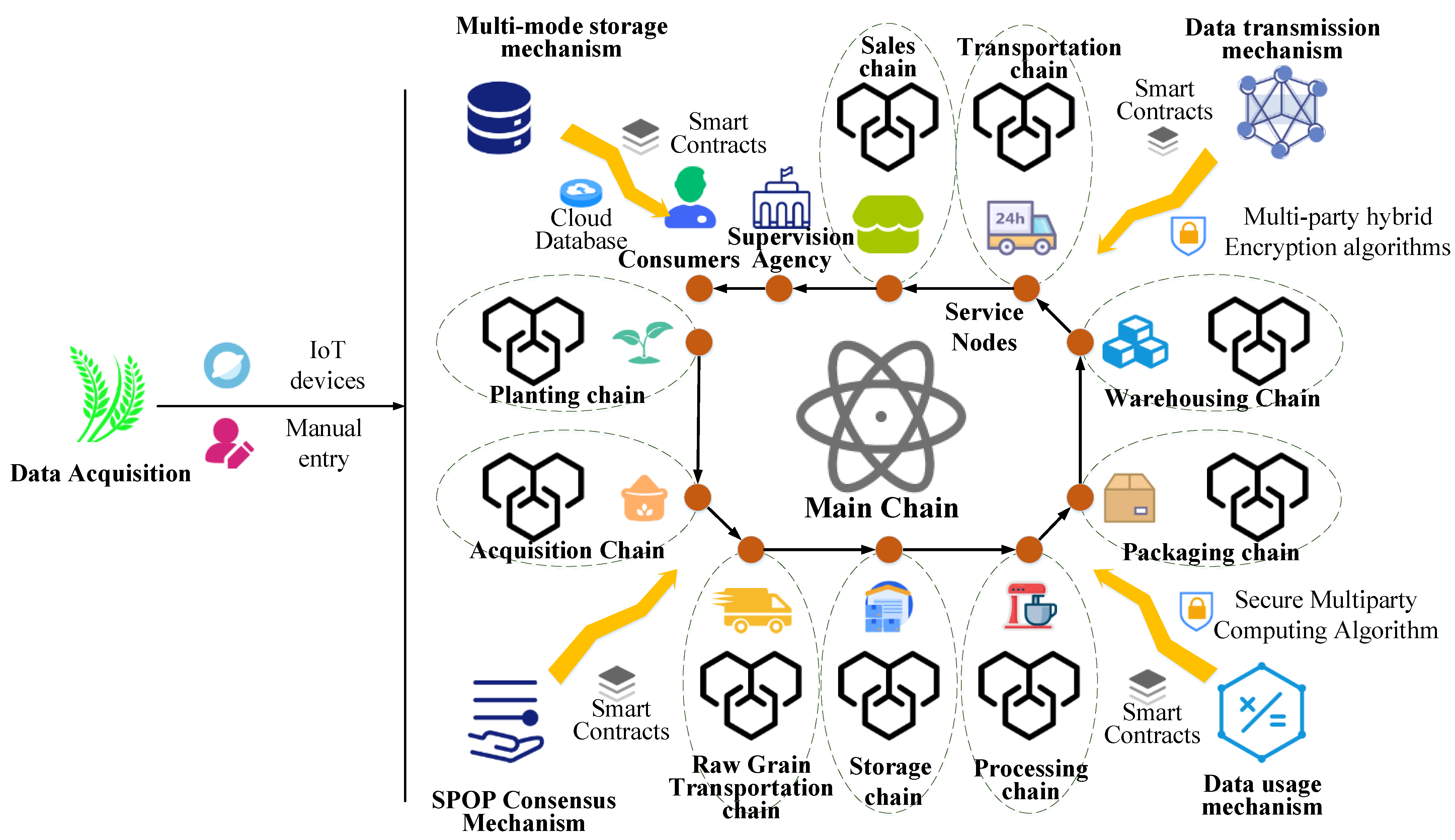
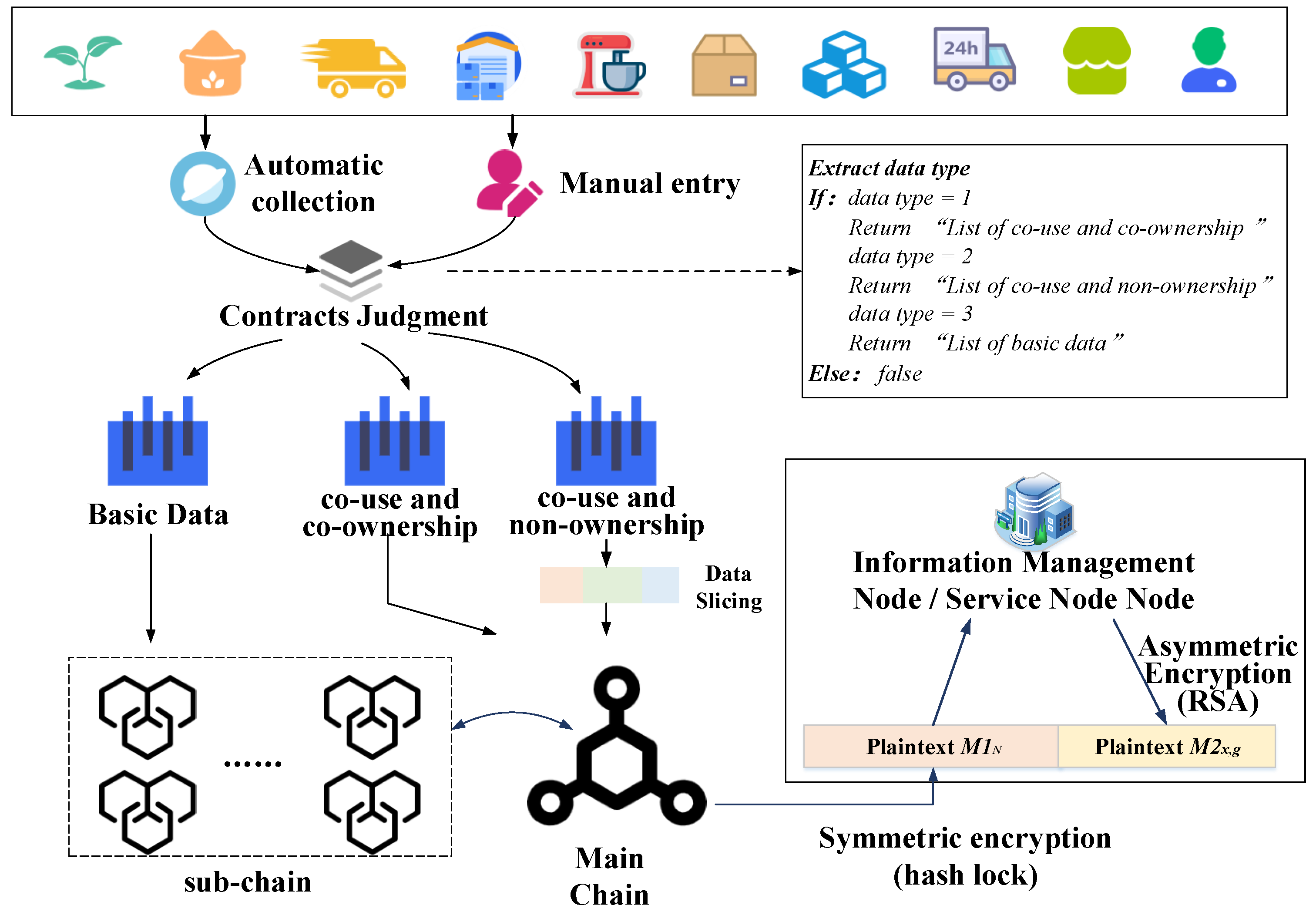
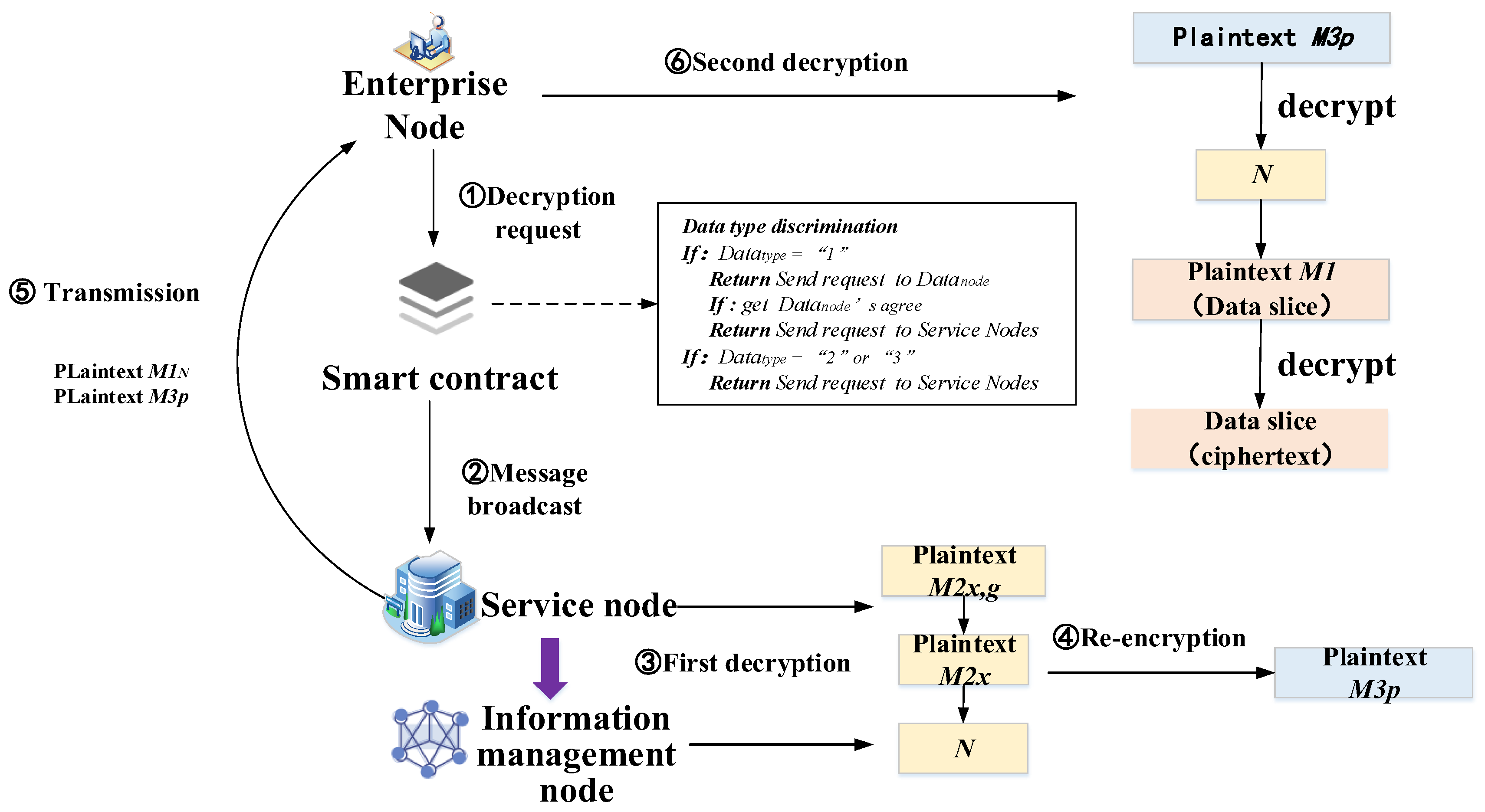
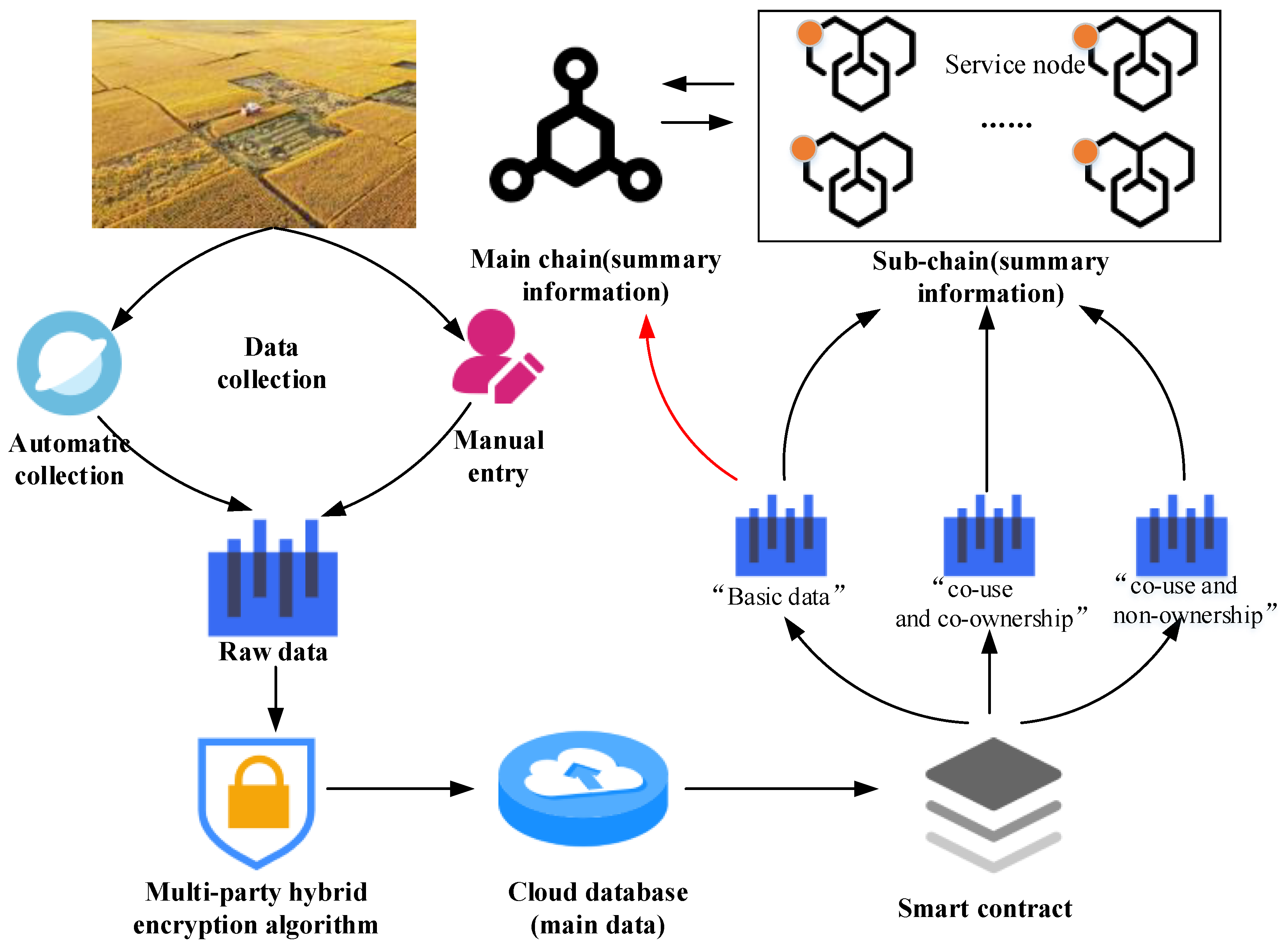
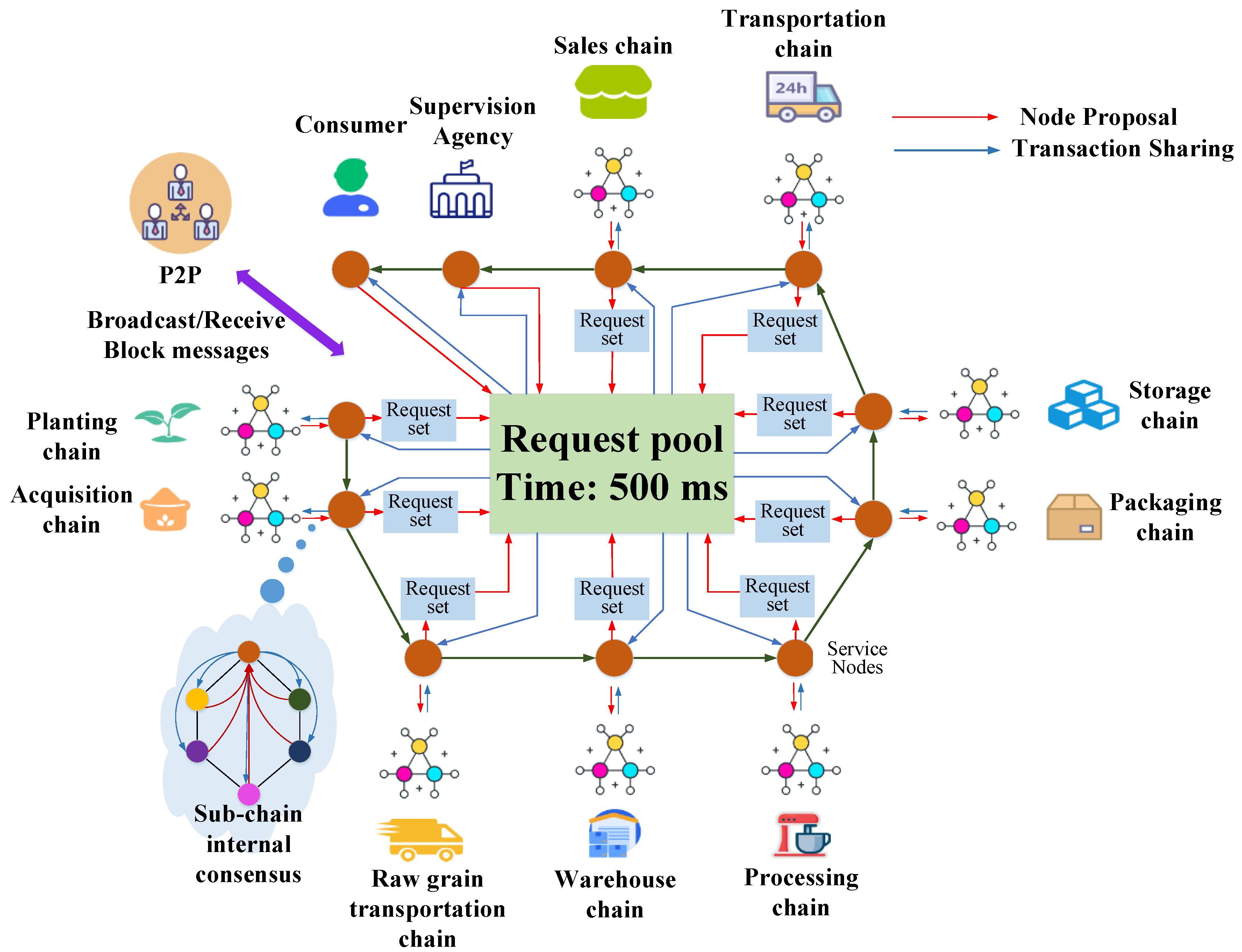
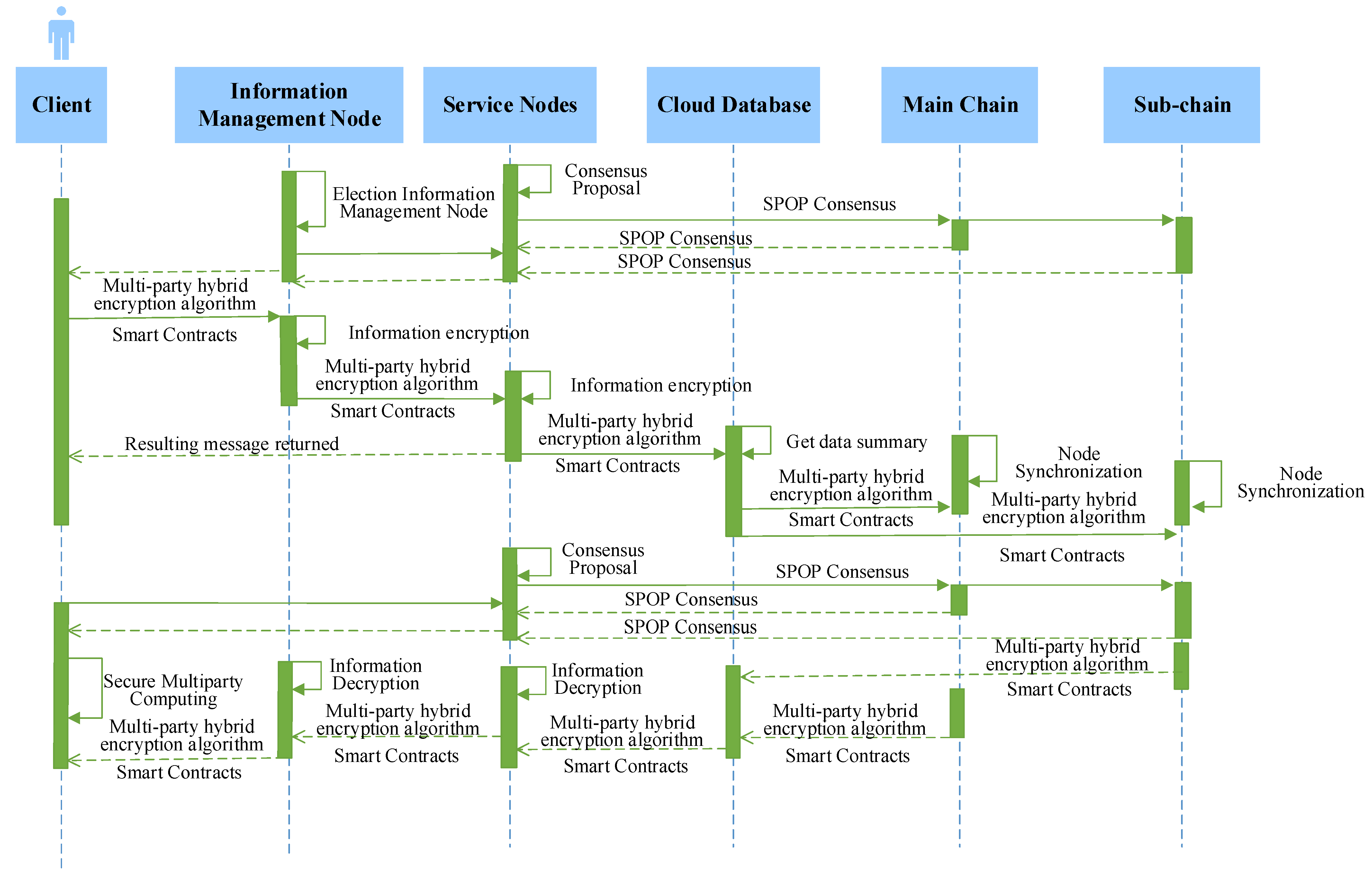
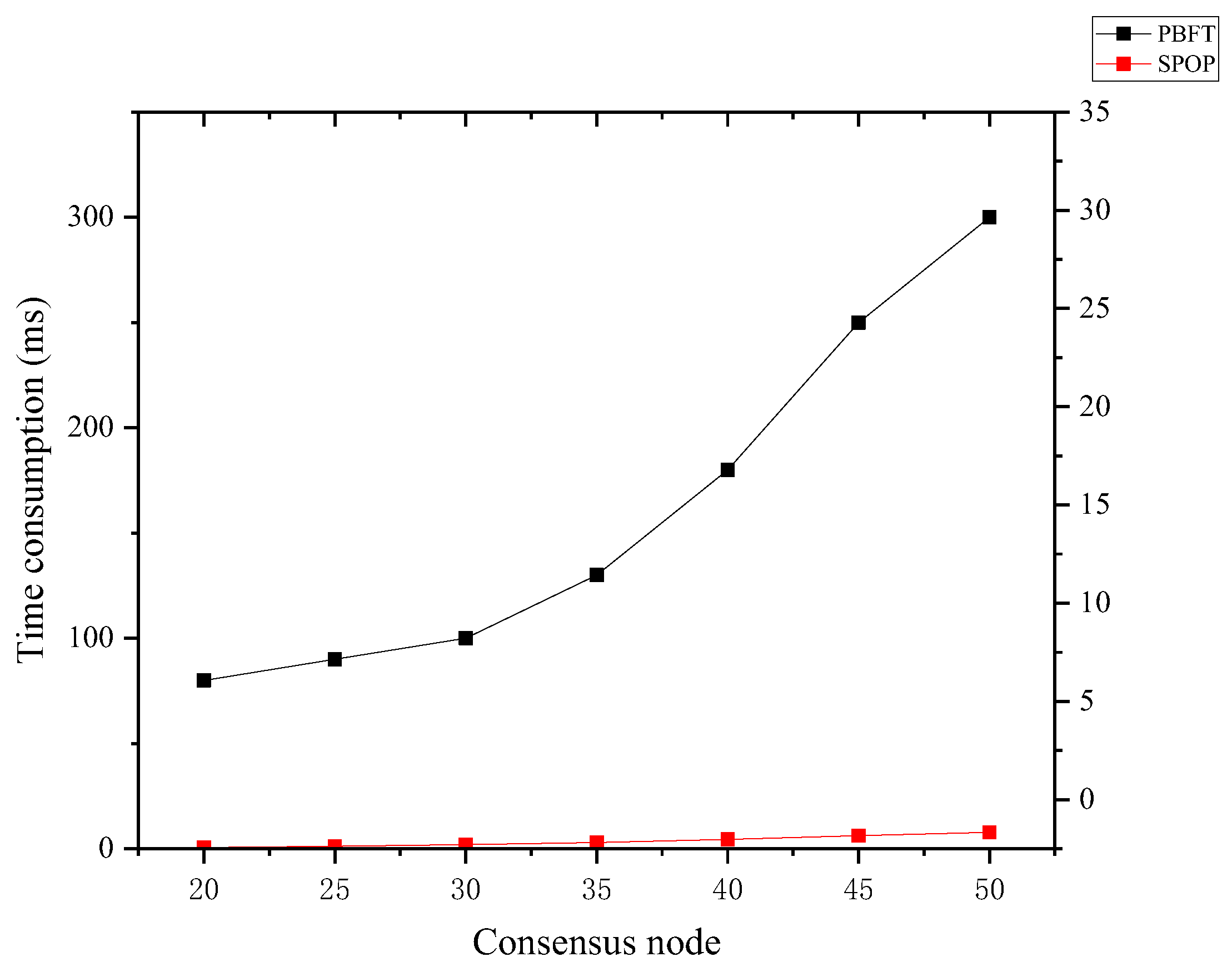
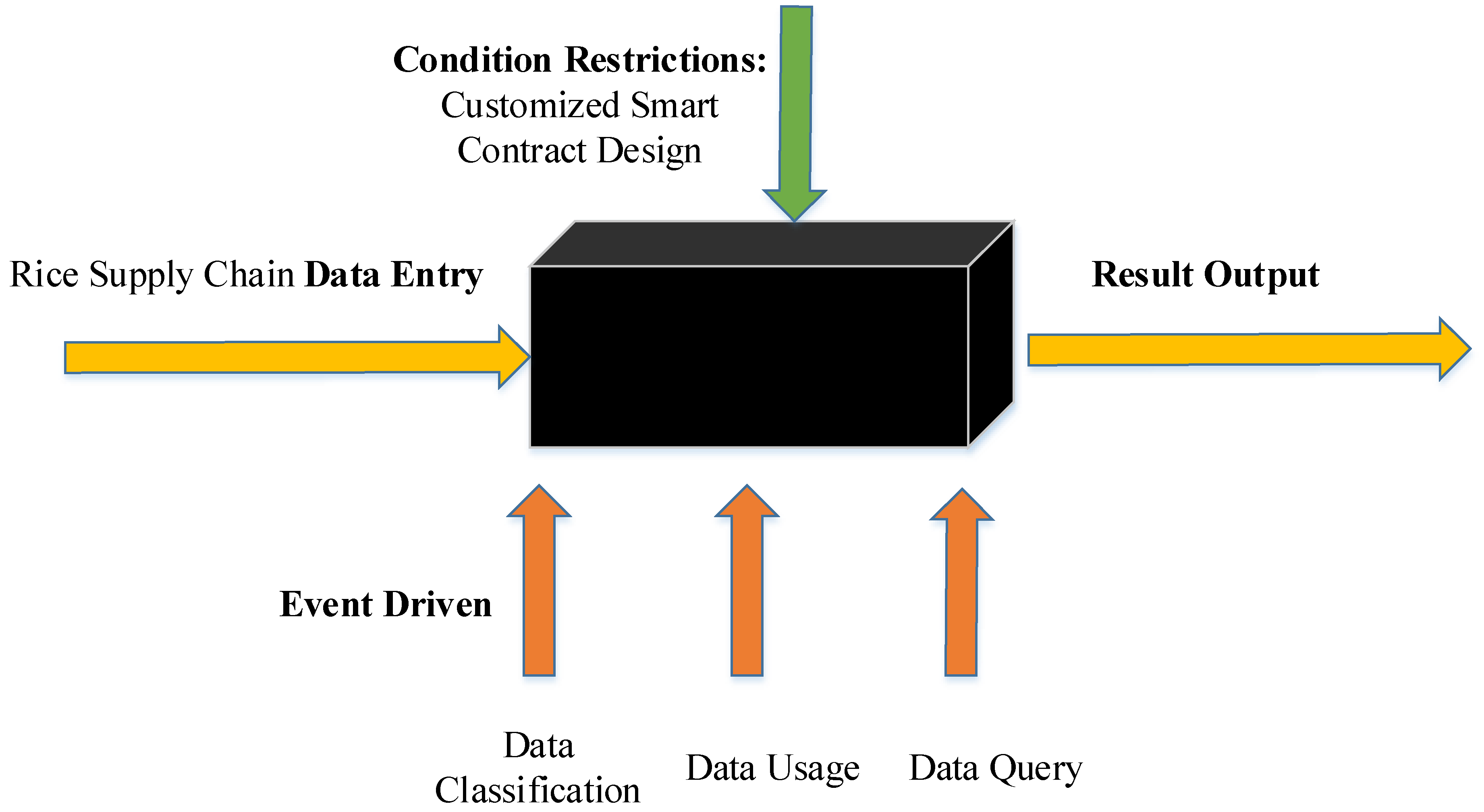
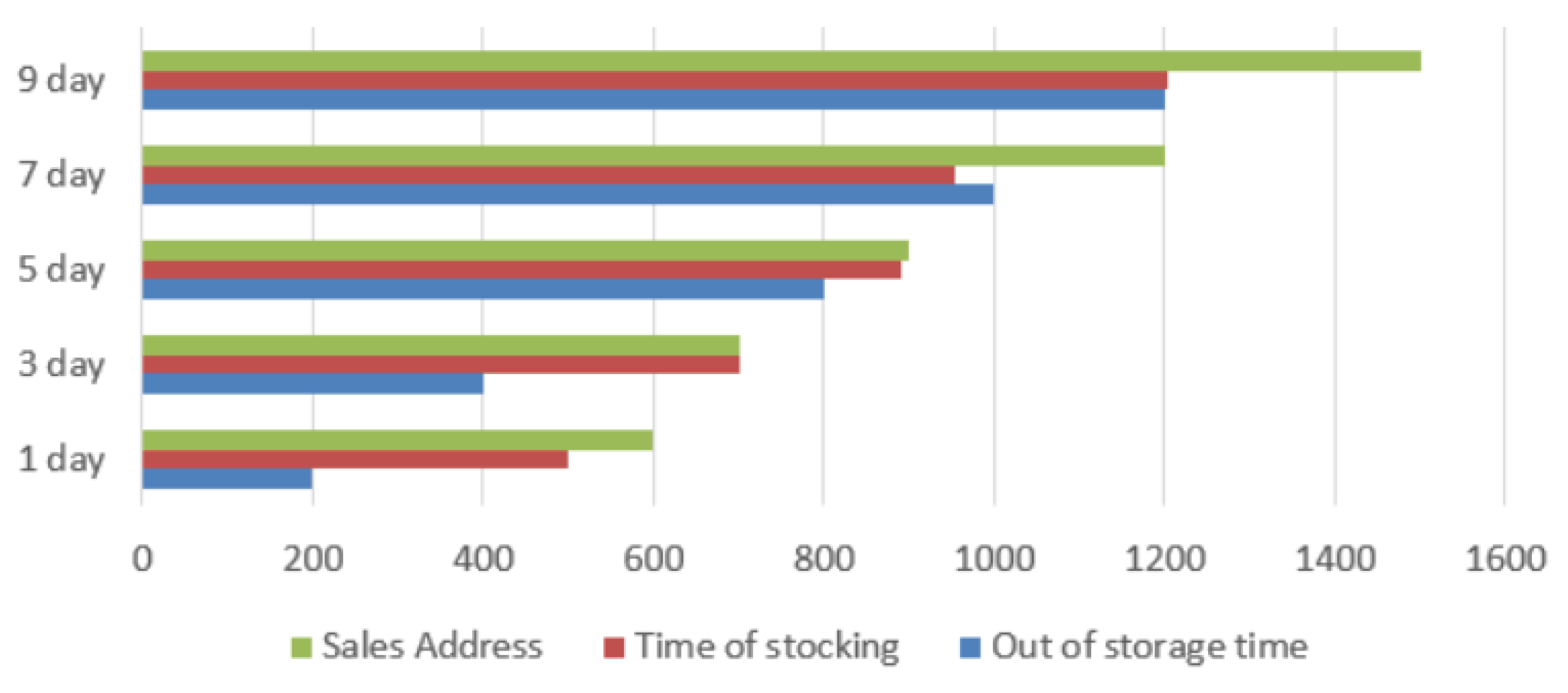
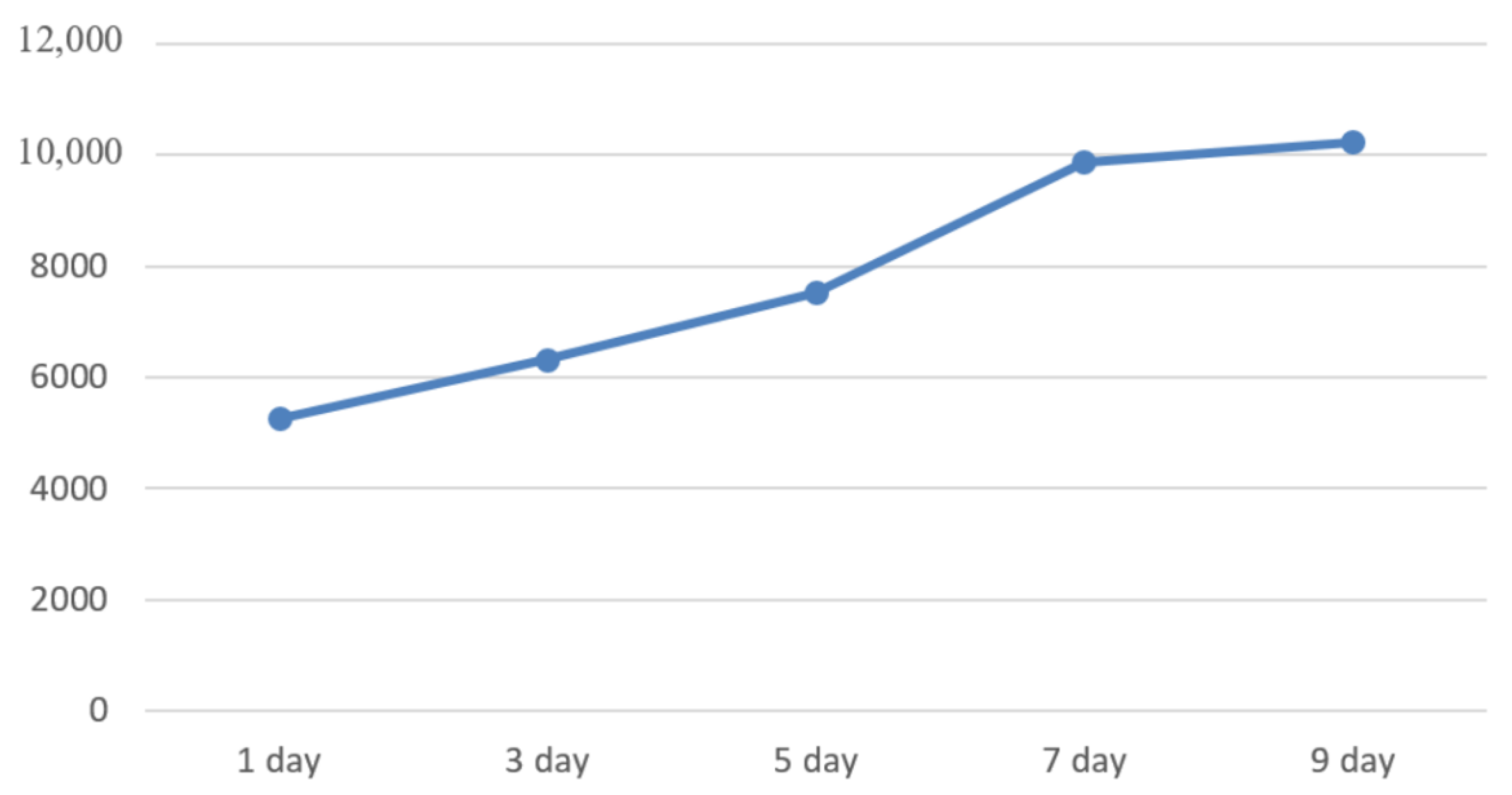
| Category | Main Content | References |
|---|---|---|
| Blockchain-based theoretical study of applications in the field of agricultural products and food | Analyze the existing research and study the opportunities and challenges of blockchain research in the field of agricultural products and food. | [34,35,36] |
| Blockchain-based data application methods in the field of agricultural products and food | Focuses on the use of blockchain to trace and manage agricultural products and food supply chain data. | [37,38,39] |
| Blockchain-based architecture innovation and improvement research in the field of agricultural products and food | Innovative design and application of new blockchain architecture to improve the scalability of blockchain in agricultural and food applications. | [40,41,42,43] |
| Blockchain-based research on the trusted interaction of data in agricultural products and food | Research the integrated application of trusted encryption mechanism, Internet of Things technology, etc., with blockchain technology to ensure the trusted interaction of data. | [44,45,46] |
| Blockchain-based consensus research in the field of agricultural products and food | Research applies to complex requests and efficient consensus among participants in the field of agricultural products and food. | [47,48,49] |
| Basic Data | Product name/lot, inbound time, worker cost, outbound time, logistics departure time, arrival time, sales address, inbound time, selling time, product quantity, etc. | |
| Privacy data | co-use and co-ownership | Hazard information (mycotoxins, heavy metals, pesticide residues, fumigant residues, herbicide residues, molds), rice quality information (drought resistance, flood resistance, yield, pollination rate, cold resistance), whole rice/broken rice rate, etc. |
| co-use and non-ownership | Raw material cost, raw material source, fertilizer name/source, planting/harvesting time, light level, watering record, purchase inspection report, drying record report, temperature and humidity record, processing cost, rice milling/color selection/polishing method, packaging cost, transportation cost, transportation vehicle information, route information, driver information, storage cost, herbicide dosage, fumigant dosage, etc., for each link | |
| Attack Method | Sybil Attack | DDOS Attack | Smart-Contract Attack |
|---|---|---|---|
| Number of attacks | 200 | 200 | 200 |
| Number of successes | 0 | 0 | 0 |
| Percentage of successful attacks | 0% | 0% | 0% |
| Performance | Sending tps | Consensus tps | Inbound tps |
|---|---|---|---|
| RPCA consensus algorithm | 700 | 700 | 500 |
| POP consensus algorithm | 4000 | 4000 | 1800 |
| SPOP consensus algorithm | 6000 | 6000 | 2900 |
| Category | PBFT Consensus Algorithm | RPCA Consensus Algorithm | POP Consensus Algorithm | SPOP Consensus Algorithm |
|---|---|---|---|---|
| Consensus method | Two rounds of 2/3 consensus | Two rounds of 2/3 consensus | Individual proposals for each node | Hybrid proposal mechanism for master chain nodes (supervisory nodes, consumer nodes, service nodes) |
| Fault tolerance | 33% | 33% | 51% | 51% |
| Test Target | Case Number | Feature Points | Test Content | Expected Outcome | Test Results |
|---|---|---|---|---|---|
| Data classification | Case1 | Precise classification of data | Accurate classification by contract after standardization of collected data | The data are accurately classified into the category according to the category. | As expected |
| Data transmission | Case2 | Secure data transmission | Safe transmission of private data without leakage | Data are transmitted securely, without tampering or leakage. | As expected |
| Data usage | Case3 | Safe use of data | Data can be securely used for computation among multiple stakeholders | The data are used as expected. | As expected |
| Category | Seed Cost | Illumination | Watering Frequency | Fertilizer Cost |
|---|---|---|---|---|
| Average value | RMB 5.25/kg | 46,500 lux | 1.25 times/week | RMB 345/ton |
Publisher’s Note: MDPI stays neutral with regard to jurisdictional claims in published maps and institutional affiliations. |
© 2022 by the authors. Licensee MDPI, Basel, Switzerland. This article is an open access article distributed under the terms and conditions of the Creative Commons Attribution (CC BY) license (https://creativecommons.org/licenses/by/4.0/).
Share and Cite
Peng, X.; Zhang, X.; Wang, X.; Xu, J.; Li, H.; Zhao, Z.; Qi, Z. A Refined Supervision Model of Rice Supply Chain Based on Multi-Blockchain. Foods 2022, 11, 2785. https://doi.org/10.3390/foods11182785
Peng X, Zhang X, Wang X, Xu J, Li H, Zhao Z, Qi Z. A Refined Supervision Model of Rice Supply Chain Based on Multi-Blockchain. Foods. 2022; 11(18):2785. https://doi.org/10.3390/foods11182785
Chicago/Turabian StylePeng, Xiangzhen, Xin Zhang, Xiaoyi Wang, Jiping Xu, Haisheng Li, Zhiyao Zhao, and Zhibo Qi. 2022. "A Refined Supervision Model of Rice Supply Chain Based on Multi-Blockchain" Foods 11, no. 18: 2785. https://doi.org/10.3390/foods11182785
APA StylePeng, X., Zhang, X., Wang, X., Xu, J., Li, H., Zhao, Z., & Qi, Z. (2022). A Refined Supervision Model of Rice Supply Chain Based on Multi-Blockchain. Foods, 11(18), 2785. https://doi.org/10.3390/foods11182785





